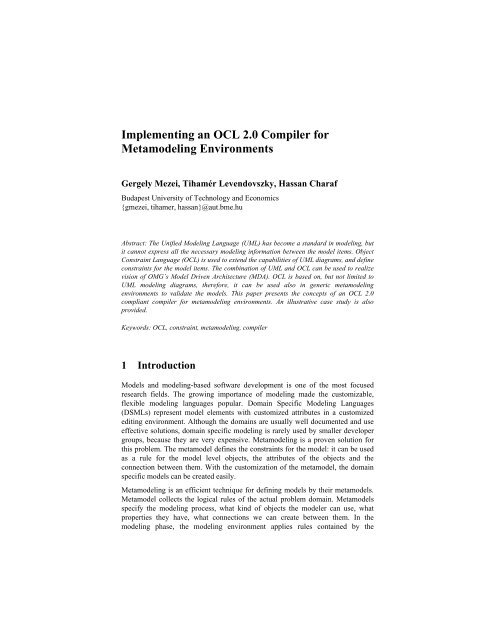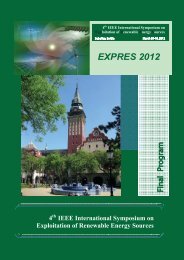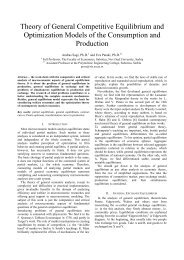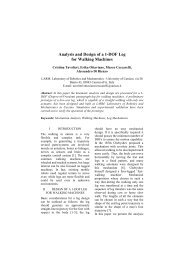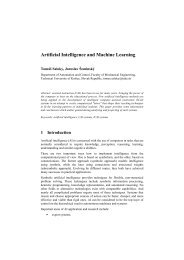Implementing an OCL 2.0 Compiler for ... - ResearchGate
Implementing an OCL 2.0 Compiler for ... - ResearchGate
Implementing an OCL 2.0 Compiler for ... - ResearchGate
Create successful ePaper yourself
Turn your PDF publications into a flip-book with our unique Google optimized e-Paper software.
<strong>Implementing</strong> <strong>an</strong> <strong>OCL</strong> <strong>2.0</strong> <strong>Compiler</strong> <strong>for</strong><br />
Metamodeling Environments<br />
Gergely Mezei, Tihamér Levendovszky, Hass<strong>an</strong> Charaf<br />
Budapest University of Technology <strong>an</strong>d Economics<br />
{gmezei, tihamer, hass<strong>an</strong>}@aut.bme.hu<br />
Abstract: The Unified Modeling L<strong>an</strong>guage (UML) has become a st<strong>an</strong>dard in modeling, but<br />
it c<strong>an</strong>not express all the necessary modeling in<strong>for</strong>mation between the model items. Object<br />
Constraint L<strong>an</strong>guage (<strong>OCL</strong>) is used to extend the capabilities of UML diagrams, <strong>an</strong>d define<br />
constraints <strong>for</strong> the model items. The combination of UML <strong>an</strong>d <strong>OCL</strong> c<strong>an</strong> be used to realize<br />
vision of OMG’s Model Driven Architecture (MDA). <strong>OCL</strong> is based on, but not limited to<br />
UML modeling diagrams, there<strong>for</strong>e, it c<strong>an</strong> be used also in generic metamodeling<br />
environments to validate the models. This paper presents the concepts of <strong>an</strong> <strong>OCL</strong> <strong>2.0</strong><br />
compli<strong>an</strong>t compiler <strong>for</strong> metamodeling environments. An illustrative case study is also<br />
provided.<br />
Keywords: <strong>OCL</strong>, constraint, metamodeling, compiler<br />
1 Introduction<br />
Models <strong>an</strong>d modeling-based software development is one of the most focused<br />
research fields. The growing import<strong>an</strong>ce of modeling made the customizable,<br />
flexible modeling l<strong>an</strong>guages popular. Domain Specific Modeling L<strong>an</strong>guages<br />
(DSMLs) represent model elements with customized attributes in a customized<br />
editing environment. Although the domains are usually well documented <strong>an</strong>d use<br />
effective solutions, domain specific modeling is rarely used by smaller developer<br />
groups, because they are very expensive. Metamodeling is a proven solution <strong>for</strong><br />
this problem. The metamodel defines the constraints <strong>for</strong> the model: it c<strong>an</strong> be used<br />
as a rule <strong>for</strong> the model level objects, the attributes of the objects <strong>an</strong>d the<br />
connection between them. With the customization of the metamodel, the domain<br />
specific models c<strong>an</strong> be created easily.<br />
Metamodeling is <strong>an</strong> efficient technique <strong>for</strong> defining models by their metamodels.<br />
Metamodel collects the logical rules of the actual problem domain. Metamodels<br />
specify the modeling process, what kind of objects the modeler c<strong>an</strong> use, what<br />
properties they have, what connections we c<strong>an</strong> create between them. In the<br />
modeling phase, the modeling environment applies rules contained by the
metamodel. The in<strong>for</strong>mation represented by a model has a tendency to be<br />
incomplete, in<strong>for</strong>mal, imprecise, <strong>an</strong>d sometimes even inconsistent. For example a<br />
UML diagram, such as a class diagram, is typically not refined enough to provide<br />
all the relev<strong>an</strong>t aspects of a specification. Beside other issues, there is a need to<br />
describe additional constraints about the objects in the model. Such constraints are<br />
often described in a natural l<strong>an</strong>guage. Practice has shown that this always results<br />
in ambiguities. For example a comp<strong>an</strong>y uses a customized modeling l<strong>an</strong>guage to<br />
model the hierarchies, <strong>an</strong>d relations between the employers. The comp<strong>an</strong>y w<strong>an</strong>ts<br />
to define a model that is only valid if all the employers are older th<strong>an</strong> eighteen<br />
years. In order to write unambiguous constraints, <strong>for</strong>mal l<strong>an</strong>guages have been<br />
developed. The disadv<strong>an</strong>tage of traditional <strong>for</strong>mal l<strong>an</strong>guages is that they require<br />
modelers with a strong mathematical background, but difficult <strong>for</strong> the average<br />
business or system modeler to use. Object Constraint L<strong>an</strong>guage (<strong>OCL</strong>) [1] is a<br />
<strong>for</strong>mal l<strong>an</strong>guage that remains easy to read <strong>an</strong>d write. It is a subset of the industry<br />
st<strong>an</strong>dard Unified Modeling L<strong>an</strong>guage [2] that allows software developers to write<br />
constraints <strong>an</strong>d queries over object models. A constraint is a restriction on one or<br />
more values of <strong>an</strong> object-oriented model or system. <strong>OCL</strong> <strong>2.0</strong> is perfect to extend<br />
the metamodel definitions in order to support model validation.<br />
Visual Modeling <strong>an</strong>d Tr<strong>an</strong>s<strong>for</strong>mation System (VMTS) [3] is <strong>an</strong> n-layer<br />
metamodeling environment that gr<strong>an</strong>ts full tr<strong>an</strong>sparency between the layers (each<br />
layer is h<strong>an</strong>dled with the same methods), <strong>an</strong>d offers graphical metamodel editing<br />
features. VMTS is implemented using Microsoft .NET Framework [4]. VMTS<br />
consists of several subsystems. The complete structure c<strong>an</strong> be seen in Fig. 1.<br />
Attributed Graph Architecture Supporting Interface (AGSI) is responsible <strong>for</strong> the<br />
graph database actions <strong>an</strong>d it offers a high-level interface <strong>for</strong> the other<br />
components. The Rule Editor <strong>an</strong>d the Rewriting Engine are used <strong>for</strong> graph<br />
tr<strong>an</strong>s<strong>for</strong>mations; Traversing Processors are used <strong>for</strong> traversing the models in order<br />
to generate program code or other artifacts. VMTS Presentation Framework is the<br />
graphical environment part of VMTS used <strong>for</strong> displaying <strong>an</strong>d editing the models<br />
with their proprietary presentation. The Constraint Validator Modules consists of<br />
two components: the <strong>OCL</strong> Modul, <strong>an</strong>d the Multiplicity Modul. <strong>OCL</strong> Modul<br />
contains the <strong>OCL</strong> <strong>Compiler</strong>, <strong>an</strong>d the related functions, Multiplicity Modul is used<br />
to check if the model contains only those types which are defined in its<br />
metamodel, <strong>an</strong>d validates the connections between the model elements.<br />
This paper discusses new results, experiences <strong>an</strong>d consequences evolved from the<br />
implementation of <strong>an</strong> <strong>OCL</strong> <strong>2.0</strong> compiler <strong>an</strong>d further conceptual development of<br />
constraint checking <strong>an</strong>d h<strong>an</strong>dling in a metamodel-based model tr<strong>an</strong>s<strong>for</strong>mation<br />
system. This work presents the constraint validation module of a metamodeling<br />
environment supporting creation, propagation <strong>an</strong>d validation of constraints in<br />
metamodels.
Figure 1<br />
The structure of VMTS<br />
2 Architecture<br />
The <strong>OCL</strong> Module is responsible <strong>for</strong> all <strong>OCL</strong> constraint-based validation. It<br />
contains not only the <strong>OCL</strong> <strong>Compiler</strong> itself, but describes how to define <strong>an</strong>d use<br />
these constraints. The <strong>OCL</strong> Module checks the metamodel containing <strong>OCL</strong><br />
constraints <strong>for</strong> the inst<strong>an</strong>ce models. The <strong>OCL</strong> Module is not a constraint<br />
interpreter, since VMTS generates validation code based on the metamodel<br />
containing <strong>OCL</strong> constraints (the constraints are attached to the metamodel items),<br />
then it compiles a binary from the generated code, <strong>an</strong>d the inst<strong>an</strong>ce models of the<br />
metamodel is checked by compiled binary against the constraints (Fig. 2). This<br />
method facilitates determining the complexity of the constraint validation method.<br />
Figure 2<br />
<strong>OCL</strong> Module<br />
<strong>Implementing</strong> a compiler is in general a complex task consisting of several welldefined<br />
subparts. The input of a compiler is a textual file written in the source<br />
l<strong>an</strong>guage, <strong>an</strong>d the output is a textual file or a binary in the target l<strong>an</strong>guage. The<br />
source l<strong>an</strong>guage <strong>an</strong>d the target l<strong>an</strong>guage c<strong>an</strong> be the same or different. The two<br />
main parts of the compilation are: (i) the <strong>an</strong>alysis of the source l<strong>an</strong>guage input,
<strong>an</strong>d (ii) the generation (synthesis) of the target l<strong>an</strong>guage output based on the<br />
retrieved sem<strong>an</strong>tic in<strong>for</strong>mation. Accordingly, the <strong>OCL</strong> <strong>Compiler</strong> realized in<br />
VMTS consists of several parts (Fig. 3). First, the user defines the constraints in<br />
<strong>OCL</strong>, then the constraint definitions are parsed <strong>an</strong>d syntactically <strong>an</strong>alyzed. The<br />
Syntax tree does not contain every necessary in<strong>for</strong>mation, it should be extended<br />
e.g. with type in<strong>for</strong>mation, <strong>an</strong>d implicit self references. This amendment is<br />
per<strong>for</strong>med in the sem<strong>an</strong>tic <strong>an</strong>alysis phase, <strong>an</strong>d it produces the Sem<strong>an</strong>tic Analyzed<br />
Syntax tree. As the next step, the constructed tree is tr<strong>an</strong>s<strong>for</strong>med to a CodeDom<br />
tree. CodeDom is a .NET-based technology that c<strong>an</strong> describe programs using<br />
abstract trees <strong>an</strong>d it c<strong>an</strong> use this tree representation to generate code to <strong>an</strong>y<br />
l<strong>an</strong>guages that is supported by the .NET CLR (like C#, Visual Basic or Java).<br />
Using CodeDom, the generated source code is syntactically correct in all cases;<br />
our task is only to deal with the appropriate sem<strong>an</strong>tic content. Finally, the<br />
compiler tr<strong>an</strong>s<strong>for</strong>ms the CodeDom tree to C# source code, it compiles <strong>an</strong>d builds<br />
it. The output of the <strong>OCL</strong> compiler is a binary executable (a .dll file) that<br />
implements the <strong>OCL</strong> constraint.<br />
Figure 3<br />
The structure of the <strong>OCL</strong> <strong>Compiler</strong><br />
3 The <strong>Compiler</strong><br />
3.1 Lexical Analysis<br />
Lexical <strong>an</strong>d syntactic <strong>an</strong>alysis are realized using the tools Flex [5] <strong>an</strong>d Bison [6].<br />
These tools are optimized <strong>an</strong>d well-tested solutions to syntax tree generation, both<br />
of them were used in thous<strong>an</strong>ds of software projects. Un<strong>for</strong>tunately Flex <strong>an</strong>d<br />
Bison tools use ANSI C code, but they were relative easy to integrate in VMTS.<br />
The first step of the lexical <strong>an</strong>alysis is the tokenization, which parses the source<br />
code <strong>an</strong>d reads lexical patterns (tokens) <strong>for</strong>m it (e.g. identifiers (name) <strong>an</strong>d the<br />
keywords of the l<strong>an</strong>guage). Tokenization eliminates the whitespaces as well as
comments. Tokenization is achieved by a table, which contains the keywords. The<br />
result of this process is a sequence of tokens, which contains the me<strong>an</strong>ing of the<br />
source program. Tokenization is made by Flex.<br />
3.2 Syntactic Analysis<br />
The next step is to create the syntax tree using the tokens. The <strong>OCL</strong> specification<br />
is used to construct the grammar rules <strong>for</strong> this step. The task of the syntactic<br />
<strong>an</strong>alysis is to find the deduction which generates the source code of the program,<br />
starting from the sentence symbol (S). The <strong>an</strong>alyzer reads the sequence of the<br />
tokens, <strong>an</strong>d, using the production rules, it generates <strong>an</strong> Abstract Syntax Tree<br />
(AST), which is a model of the program that we w<strong>an</strong>t to compile. The AST is a<br />
direct association between the rules in the grammar <strong>an</strong>d the nodes in the tree, <strong>an</strong>d<br />
it is purely <strong>an</strong> abstract representation of the syntax, modeled as a tree [7] [8]. The<br />
inner nodes of the AST contain no terminal symbols, while the leaves contain the<br />
tokens. The generation of the AST is possible if <strong>an</strong>d only if the program is<br />
syntactically correct [9].<br />
The <strong>OCL</strong> specification [1] uses EBNF notation <strong>for</strong> the grammar specification.<br />
This EBNF description had to be modified, <strong>an</strong>d simplified in certain places to be<br />
able to process it with Bison. The simplification does not reduce the expression<br />
power or the l<strong>an</strong>guage capabilities, because the in<strong>for</strong>mation avoided by the<br />
simplification is reconstructed in the sem<strong>an</strong>tic <strong>an</strong>alysis step.<br />
The first problem was with the EBNF specification that it uses the ? (optional<br />
element), the * (0..* multiplicity) <strong>an</strong>d the + (1..* multiplicity) notations.<br />
These symbols had to be modified in order to be able to process to Bison. Table 1.<br />
contains the original <strong>an</strong>d the modified rules.<br />
Original rules<br />
Reworked rules<br />
A -> b c? d A -> b d | b c d<br />
A -> b c* d A -> b optionalC d<br />
optionalC -> /* empty */<br />
| optionalC c<br />
A -> b c+ d A -> b optionalC d<br />
optionalC -> c<br />
| optionalC c<br />
Table 1<br />
Reworked EBNF rules <strong>for</strong> Bison<br />
The second problem is that several rules in the <strong>OCL</strong> specification cause<br />
shift/reduce or reduce/reduce conflicts. To solve this problem, the rules had to be<br />
tr<strong>an</strong>s<strong>for</strong>med. There are rules that c<strong>an</strong> be tr<strong>an</strong>s<strong>for</strong>med, divided, or unified to<br />
support the specification, but there are rules that needed to process additional
(sem<strong>an</strong>tic) in<strong>for</strong>mation. For example, both VariableExpressions <strong>an</strong>d<br />
AttributeCalls c<strong>an</strong> be defined by a single name (the name of the variable or the<br />
attribute). This two case c<strong>an</strong> not be distinguished at the level of the tokens,<br />
because the compiler should check whether there is a variable defined with the<br />
name (<strong>an</strong>d the current expression is in the scope of the variable), or the model<br />
items has <strong>an</strong> attribute with the name. There are five simplification groups that<br />
c<strong>an</strong>not be solved without sem<strong>an</strong>tic in<strong>for</strong>mation:<br />
• AttributeCall c<strong>an</strong> conflict with VariableExpression<br />
• NavigationCall c<strong>an</strong> conflict with AttributeCall<br />
• VariableExpressions c<strong>an</strong> conflict with AttributeCalls<br />
• EnumerationLiterals c<strong>an</strong> conflict with AttributeCalls<br />
• Iterators with <strong>an</strong> overridden operation c<strong>an</strong> conflict with<br />
Attribute/NavigationCall<br />
The complete <strong>OCL</strong> specification c<strong>an</strong> be found on the VMTS homepage [3].<br />
3.3 Sem<strong>an</strong>tic Analysis<br />
The text of the constraint is tokenized, <strong>an</strong>d the syntax tree is constructed. The next<br />
step is to <strong>an</strong>alyze the syntax tree sem<strong>an</strong>tically, <strong>an</strong>d add all in<strong>for</strong>mation that is<br />
required by the further steps. In VMTS this step begins with a substep of<br />
interoperability communication between the unm<strong>an</strong>aged code generated by Bison,<br />
<strong>an</strong>d the m<strong>an</strong>aged code of VMTS. Fortunately this substep is relative easy: the<br />
unm<strong>an</strong>aged data structure c<strong>an</strong> be fit the m<strong>an</strong>aged structure using the .NET<br />
recommendations.<br />
With the syntax tree constructed by Bison there are three problems. (1) <strong>OCL</strong><br />
allows leaving out the self identifier if it does not cause ambiguity. These<br />
identifiers are required to generate code from the constraints. (2) The code<br />
generation <strong>an</strong>d, generally, the type checking require the type in<strong>for</strong>mation included<br />
in the nodes. (3) During the syntax tree construction there was a few<br />
simplifications that should be corrected.<br />
The missing self identifier is the easiest to h<strong>an</strong>dle. If the currently processed node<br />
is a NavigationCall, AttributeCall or OperationCall (i.e. the node uses some kind<br />
of model in<strong>for</strong>mation) then it is recursively examined. The self identifier should be<br />
inserted only if the innermost expression is not self. This algorithm ensures that<br />
every model-based operation use self as the start point. Model-independent<br />
operations (like definition of temporary variables) do not need self (neither in the<br />
code generation, nor according to the <strong>OCL</strong> specification).<br />
In the <strong>OCL</strong> <strong>Compiler</strong>, we c<strong>an</strong>not use the traditional symbol table, because the<br />
symbols are not in the code to be compiled, but it must be obtained from <strong>an</strong>other
place, namely, from the VMTS model database. There<strong>for</strong>e instead of the static<br />
symbol table, we use a dynamic solution. The nodes in the syntax tree are<br />
decorated with the appropriate type in<strong>for</strong>mation (the type in<strong>for</strong>mation is added to<br />
the nodes in the tree) <strong>an</strong>d a dynamic symbol table is also created (<strong>for</strong> faster access<br />
of the type in<strong>for</strong>mation). The decoration of the nodes is combined with type<br />
checking. The <strong>an</strong>alysis starts at the root of the tree. If the type checking fails then<br />
the compiler throws <strong>an</strong> error message, if it succeeds then the child nodes are<br />
processed recursively.<br />
Type checking c<strong>an</strong> be h<strong>an</strong>dled in m<strong>an</strong>y ways, but if the decorated type in<strong>for</strong>mation<br />
not only defines the base type of the node (e.g. Integer), but also describes the<br />
available operations with the type of the result, then the type checking is simple.<br />
To support this, the compiler defines base classes <strong>for</strong> the available types, <strong>an</strong>d all<br />
type in<strong>for</strong>mation contains <strong>an</strong> inst<strong>an</strong>ce of the appropriate type. The bases classes<br />
are classes supporting <strong>OCL</strong> base types (e.g. String, Set, Bag) <strong>an</strong>d the model types<br />
(ModelItem, ModelAttribute). These classes contain a common function<br />
GetTypeInfo (string methodName, object[] additionalParam)<br />
This function returns with a type of the operation identified by methodName (or<br />
null if the operation is not defined <strong>for</strong> the current type). In general this in<strong>for</strong>mation<br />
could be gained also by using .NET Reflection, but there are certain methods (e.g.<br />
intersection in Bag), where the type of the result depends on the parameters (here<br />
it is solved using the additionalParam parameter). In summary type in<strong>for</strong>mation<br />
c<strong>an</strong> fully describe the available operations <strong>an</strong>d the result types.<br />
The last problem is the reconstruction of the simplifications made in the<br />
syntactical <strong>an</strong>alysis. Each of the five simplification groups should be h<strong>an</strong>dled<br />
separately, but the algorithm behind is the same <strong>for</strong> each group: (i) The node is<br />
processed as long as the required sem<strong>an</strong>tic is not known (this me<strong>an</strong>s typically the<br />
processing the first child node). (ii) We check the model in<strong>for</strong>mation (whether the<br />
model has <strong>an</strong> attribute with the name) or the variable-scope in<strong>for</strong>mation (whether<br />
there is a variable defined with that name in the scope) <strong>an</strong>d check whether the type<br />
of the node should be ch<strong>an</strong>ged. (iii) If the type of the node has ch<strong>an</strong>ged, the<br />
compiler generates or modifies the new node structure, swaps the old <strong>an</strong>d the new<br />
node in the tree <strong>an</strong>d <strong>an</strong>alyzes the new node (iv) If the type of the node was correct,<br />
then processing the node continues. Fortunately, the ch<strong>an</strong>ges made in the type of<br />
the node do not affect the <strong>an</strong>cestors of the node.<br />
3.4 Code Generation<br />
The syntax tree was sem<strong>an</strong>tically <strong>an</strong>alyzed; there<strong>for</strong>e it contains all the necessary<br />
in<strong>for</strong>mation required by the code generation. Code generation is realized using the<br />
System.CodeDom namespace of .NET Framework [10]. This me<strong>an</strong>s that the code<br />
generation is a syntax tree composition, from which the framework generates the
source code. CodeDom has m<strong>an</strong>y adv<strong>an</strong>tages, <strong>for</strong> example, it supports the code<br />
generation <strong>for</strong> m<strong>an</strong>y l<strong>an</strong>guages, <strong>an</strong>d syntax checking in the generated source code<br />
c<strong>an</strong> be avoided, since CodeDom ensures that it is be syntactically correct in all<br />
cases.<br />
<strong>OCL</strong> constraints c<strong>an</strong> be of five base types: Initial Values, Derivation Rules,<br />
Invari<strong>an</strong>ts, Virtual Attribute or Operation Definitions <strong>an</strong>d OperationConstraints.<br />
The current implementation of the <strong>OCL</strong> compiler h<strong>an</strong>dles only the invari<strong>an</strong>t types<br />
in the code generation, because only this type of constraints c<strong>an</strong> be used to<br />
validate a static model (a model that c<strong>an</strong> not ch<strong>an</strong>ge its state). The non-invari<strong>an</strong>t<br />
types are sem<strong>an</strong>tically <strong>an</strong>alyzed, only the code generation steps does not compile<br />
them into source code.<br />
The generated source code should support the operation of the <strong>OCL</strong>-based types<br />
defined in the <strong>OCL</strong> specification. This me<strong>an</strong>s that either the generated source code<br />
should contain the operation logic, or a class library is required with the base<br />
classes, <strong>an</strong>d the source code inst<strong>an</strong>tiate the classes <strong>an</strong>d use them. The first solution<br />
is neither eleg<strong>an</strong>t, nor efficient, thus, VMTS uses the second solution. The<br />
compiler already has classes <strong>for</strong> the base types (recall the type in<strong>for</strong>mation<br />
checking part of the sem<strong>an</strong>tic step). These classes are extended with the necessary<br />
operations <strong>an</strong>d they are used in the implementation. Using theses classes the<br />
operations contained by the constraints c<strong>an</strong> easily be expressed in the C#<br />
l<strong>an</strong>guage. While the version of C# used in development does not support class<br />
templates, the implementation of the collection types is more complex, th<strong>an</strong> it<br />
would be with generics.<br />
The tr<strong>an</strong>s<strong>for</strong>mation of the syntax tree to the CodeDom tree is easy, because each<br />
node type has <strong>an</strong> appropriate code sequence i.e. CodeDom tree br<strong>an</strong>ch. Packages<br />
are tr<strong>an</strong>s<strong>for</strong>med to namespaces, contexts are realized with classes, <strong>an</strong>d constraint<br />
expression as public methods. Contexts have a self attribute that is used the same<br />
way as in the <strong>OCL</strong> expressions; this attribute is initialized in the constructor of the<br />
class. To h<strong>an</strong>dle the invari<strong>an</strong>ts simply, the context class has always a method<br />
(checkInvari<strong>an</strong>ts) that calls the methods of the invari<strong>an</strong>ts one after the other.<br />
There is only one decision left that deserves word in the Syntax tree to CodeDom<br />
tr<strong>an</strong>s<strong>for</strong>mation. The OclExpression c<strong>an</strong> be tr<strong>an</strong>s<strong>for</strong>med either to classes, methods,<br />
or simple code expressions. The simpler the generated CodeDom tree is, the faster<br />
the binary executer will be. If there is a separated class <strong>for</strong> every OclExpression,<br />
then the source code is well separated, easy-to-read, but it contains a lot of<br />
redund<strong>an</strong>cy. If the OclExpressions are h<strong>an</strong>dled as simple code expressions, then<br />
source code is very small, but neither user-friendly, nor easy to debug. There<strong>for</strong>e<br />
in VMTS the <strong>OCL</strong>Expressions are tr<strong>an</strong>slated as methods. This decision facilitate<br />
the code generation <strong>for</strong> complex OclExpressions like iterators.<br />
The source code generation based on a CodeDom tree is a simple function call,<br />
<strong>an</strong>d the .NET technology offers also functions to compile <strong>an</strong>d build the<br />
constructed source code.
4 Case Study<br />
Using a case study, we introduce how VMTS generates source code from a simple<br />
<strong>OCL</strong> constraint. The case study is about a computer m<strong>an</strong>ufacturer comp<strong>an</strong>y that<br />
makes CDs, flash memories, <strong>an</strong>d pen drives. The models are used <strong>for</strong> statistical<br />
calculations. Although both the constraint example <strong>an</strong>d the model itself are very<br />
simple, they are useful to see how the compiler works.<br />
Figure 4<br />
Metamodel of the Comp<strong>an</strong>y<br />
The metamodel of the case study is shown in Fig. 4. The attributes are not visible<br />
in the picture, Comp<strong>an</strong>y has three attributes: Name (string), Location (string),<br />
Income (<strong>an</strong>nual income in Euros, integer). All products have two attributes:<br />
Capacity (in Mbs, integer), <strong>an</strong>d serialNumber (string).<br />
Without constraints there are no validation facilities in the model, a CD with 1Mb<br />
capacity, or a Comp<strong>an</strong>y with fictive location c<strong>an</strong> be created without <strong>an</strong>y problem.<br />
The metamodel definition should be extended.<br />
The example constraint (Fig. 5) is used to validate the capacity of the CDs. The<br />
constraint supposes the capacity of the CDs is always 650Mb (to make the<br />
constraint simpler).<br />
package CaseStudyPackage<br />
context CD<br />
inv capacityChecker:<br />
Capacity = 650<br />
endpackage<br />
Figure 5<br />
Capacity constraint
Figure 6<br />
Capacity constraint – syntax tree<br />
First, the <strong>OCL</strong> compiler constructs the syntax tree (Fig. 6) using the grammar<br />
rules. The root is the <strong>OCL</strong>File node that is not the par of the <strong>OCL</strong> st<strong>an</strong>dard, but<br />
allows defining multiple packages in one validation source. The syntax tree shows<br />
the structure of the <strong>OCL</strong> source file in <strong>an</strong> expressive way. This expression<br />
contains <strong>an</strong> only constraint, namely, the capacityChecker invari<strong>an</strong>t constraint that<br />
contains a simple OclExpression to compare the value of <strong>an</strong> attribute (Capacity) to<br />
a literal (650). Second, the sem<strong>an</strong>tic <strong>an</strong>alysis processes the syntax tree. The nodes<br />
are decorated with type in<strong>for</strong>mation, <strong>an</strong>d the missing self reference is inserted<br />
(Fig. 7). This time each node in the syntax tree has its correct type, hence, the third<br />
step of sem<strong>an</strong>tic <strong>an</strong>alysis c<strong>an</strong> be skipped. At the end of the syntax tree <strong>an</strong>alysis the<br />
nodes has correct type in<strong>for</strong>mation (e.g. the type of the outermost OclExpression<br />
in Fig. 7 is Integer)<br />
Figure 7<br />
<strong>Compiler</strong> inserted self node<br />
The last step is the code generation from the syntax tree. The source code (Fig. 8)<br />
uses the concepts introduced earlier: a package is tr<strong>an</strong>s<strong>for</strong>med to a namespace, a
context to a class, <strong>an</strong> invari<strong>an</strong>t to a method. The self value is provided to access<br />
the model attributes, <strong>an</strong>d the checkInvari<strong>an</strong>ts method to validate the model. The<br />
two parts of the relation (Capacity = 650) are realized by two methods according<br />
to the tree representation.<br />
namespace OclRuntime.Generated.CaseStudyPackage<br />
{<br />
public class CD<br />
{<br />
ModelItem self;<br />
public CD()<br />
{self=new ModelItem(2282);}<br />
public <strong>OCL</strong>Boole<strong>an</strong> checkInvari<strong>an</strong>ts()<br />
{return Constraint_34_capacityChecker();}<br />
private <strong>OCL</strong>Boole<strong>an</strong> Constraint_34_capacityChecker()<br />
{return (AttributeCall_39() == Literal_45());}<br />
private <strong>OCL</strong>Integer AttributeCall_39()<br />
{return self.Capacity;}<br />
private <strong>OCL</strong>Integer Literal_45()<br />
{return 650; }<br />
}<br />
}<br />
Figure 8<br />
The generated source code<br />
Conclusions<br />
This paper has presented the main concepts of <strong>an</strong> <strong>OCL</strong> <strong>Compiler</strong> in <strong>an</strong> n-layer<br />
metamodeling system. The paper has discussed the steps in depth from the lexical<br />
<strong>an</strong>d syntactic <strong>an</strong>d sem<strong>an</strong>tic <strong>an</strong>alysis to the code generation. The <strong>OCL</strong> <strong>an</strong>d<br />
metamodeling-based problems <strong>an</strong>d its solutions were focused. Although the <strong>OCL</strong><br />
<strong>Compiler</strong> was realized mainly using the .NET technology, the solutions <strong>an</strong>d<br />
concepts presented in this work c<strong>an</strong> be useful to <strong>an</strong>other constraint compiler<br />
processes. The solutions were presented using <strong>an</strong> illustrative case study that has<br />
shown the underlying mech<strong>an</strong>isms in operation.<br />
The presented <strong>OCL</strong> <strong>Compiler</strong> is useful to validate the models, but neither the<br />
generated code, nor the compiler contains optimization algorithms. There<strong>for</strong>e the<br />
presented method c<strong>an</strong> validate the models, but it c<strong>an</strong> use more resources then<br />
necessary. For example the generated code above has a separated code <strong>for</strong><br />
Literal_45 in turn the expression “650” could be inserted directly into the code<br />
(because it is a primitive literal type).
Another weakness is that the <strong>OCL</strong> specification does not have a <strong>for</strong>malism to<br />
define custom error messages. If <strong>an</strong> invari<strong>an</strong>t fails, the user does not receive <strong>an</strong>y<br />
additional in<strong>for</strong>mation about the reason of the failure. Since the <strong>OCL</strong> st<strong>an</strong>dard<br />
does not h<strong>an</strong>dle it but the users may need this feature, the compiler <strong>an</strong>d the<br />
framework should offer a solution.<br />
Future work focuses primary on these fields, <strong>an</strong>d extends the <strong>OCL</strong> <strong>Compiler</strong> to<br />
support the a<strong>for</strong>ementioned functions missing.<br />
Acknowledgements<br />
The found of “Mobile Innovation Centre” has supported, in part, the activities<br />
described in this paper.<br />
References<br />
[1] Object Constraint L<strong>an</strong>guage Specification (<strong>OCL</strong>), www.omg.org<br />
[2] UML <strong>2.0</strong> Specification http://www.omg.org/uml/<br />
[3] VMTS Web Site http://avalon.aut.bme.hu/~tihamer/research/vmts<br />
[4] Thu<strong>an</strong> Thai <strong>an</strong>d Ho<strong>an</strong>g Lam, .NET Framework Essentials (O’Reilly, 2003)<br />
[5] Flex, Official Homepage, http://www.gnu.org/software/flex/<br />
[6] Bison, Official Homepage, http://www.gnu.org/software/bison/bison.html<br />
[7] David Akehurst, Octavi<strong>an</strong> Patrascoiu: <strong>OCL</strong> <strong>2.0</strong> - <strong>Implementing</strong> the<br />
St<strong>an</strong>dard <strong>for</strong> Multiple Metamodels, Workshop Proceedings, 6 th<br />
International Conference on the UML <strong>an</strong>d its Applications,<br />
2003, ENTCS, Oct. 2003<br />
[8] Ali Hamie, John Howse, Stuart Kent: Interpreting the Object Constraint<br />
L<strong>an</strong>guage, Proceedings 5 th Asia Pacific Software Engineering Conference<br />
(APSEC '98), December 2-4, 1998, Taipei, Taiw<strong>an</strong>, 1998<br />
[9] Sten Loecher, Stef<strong>an</strong> Ocke: A Metamodel-Based <strong>OCL</strong>-<strong>Compiler</strong> <strong>for</strong> UML<br />
<strong>an</strong>d MOF. In <strong>OCL</strong> <strong>2.0</strong> - Industry st<strong>an</strong>dard or scientific playground,<br />
Workshop Proceedings, 6 th International Conference on the UML <strong>an</strong>d its<br />
Applications, 2003, ENTCS, Oct. 2003<br />
[10] Microsoft .NET Framework http://msdn.microsoft.com/netframework/


